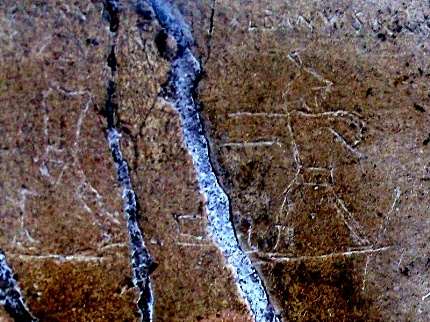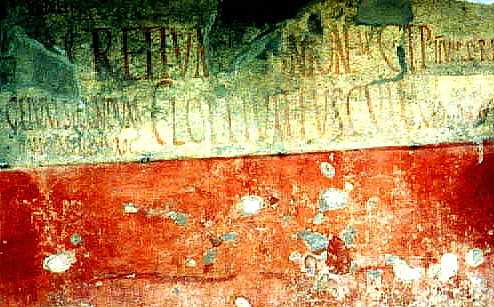
THE SCRAWL ON THE WALL!

The two types of wall inscriptions are dipinti and graffiti and these are quite distinct from the inscriptions found on tombstones and official carvings.
The word "graffiti" comes from the word "graffito" which refers to the scratching of a design on a surface. Well, that`s one school of thought. Others believe that it originates from "sgraffitio" where a layer of pigment was scratched to reveal the underlying one. It certainly refers to the ancient skill of scratching work into walls as in frescoes.
Graffiti was imposed on walls by means of a stylus or other sharp instrument, and dipinti painted on. Dipinti were announcements or "formal" programme s while graffiti were spontaneous.
In its old form graffiti has been around for centuries and examples have been found at Mayan sites, Roman villas and especially in the buried towns of Pompeii and Herculaneum. The reasons why people take such time and trouble to produce these "writings" are complex. It might be a desire to announce something portentous; to get back at someone; to acclaim one`s love of a person; to leave a message, or simply a desire for some form of public recognition.
It has been said that the first example of "modern style" graffiti can be seen today in Ephesus (Turkey). This depicts a handprint, a footstep and a number. Tour guides state that these advertise prostitution, the number of steps one would need to take to find such a place, or person, and the payment.
 In Pompeii, graffiti preserved by the eruption still exists. In the house of our old friend Caecilius Iucundus someone wrote: "Whoever loves, let him flourish. Let him perish who knows not love. Let him perish twice over whoever forbids love." If every picture is supposed to tell a story those words also might have a story to recount. Caecilius kept slaves. Are these the words of an embittered slave forbidden to love another slave? They certainly have more poignancy than the words "Staphylus was here with Quieta" found on a peristyle in the same house and reminiscent of modern-day graffiti.
In Pompeii, graffiti preserved by the eruption still exists. In the house of our old friend Caecilius Iucundus someone wrote: "Whoever loves, let him flourish. Let him perish who knows not love. Let him perish twice over whoever forbids love." If every picture is supposed to tell a story those words also might have a story to recount. Caecilius kept slaves. Are these the words of an embittered slave forbidden to love another slave? They certainly have more poignancy than the words "Staphylus was here with Quieta" found on a peristyle in the same house and reminiscent of modern-day graffiti.
I find the Pompeiian graffiti greatly interesting for it shows us what the ordinary citizen was like. Here we can find statements of love, insults, challenges, innuendos, warnings and advice. We meet Celadus Crescens and learn: Suspirium puellarum Celadus thraex: "Celadus the Thracier makes the girls sigh." We find the address of Novellia Primigenia of Nuceria, a noted beauty who might have been a girl with a reputation, or merely the subject of a disgruntled would-be suitor out to discredit her name.
We laugh at:
Quisquis amat. veniat. Veneri volo frangere costas
fustibus et lumbos debilitare deae.
Si potest illa mihi tenerum pertundere pectus
quit ego non possim caput illae frangere fuste?
Whoever loves, go to hell. I want to break Venus's ribs
with a club and deform her hips.
If she can break my tender heart
why can't I hit her over the head?
 On Pompeii's walls are notes left by shopkeepers, students, lovers, gladiators, tourists, fans, swindlers and business men and women.
We learn important news, of elections, public entertainment and advertisements, written or drawn on the walls of the buildings.
On Pompeii's walls are notes left by shopkeepers, students, lovers, gladiators, tourists, fans, swindlers and business men and women.
We learn important news, of elections, public entertainment and advertisements, written or drawn on the walls of the buildings.
Examples of such graffiti and inscriptions include:
"Someone at whose table I do not dine, Lucius Istacidius, is a barbarian to me."
Lucrum gaudium.
" Profit is happiness"
"Samius says to Cornelius: Go hang!"
Lucius pinxit.
Lucius painted this.
Oppi, emboliari, fur, furuncule.
Oppius, clown, thief, petty crook!
Pituita me tenet.
I've caught a cold.
amantes ut apes vitam mellitam exigunt. -vellem.
Lovers, like bees, live a honeyed life. - I wish!
These are only a few examples of graffiti "scrawled" on the walls. It is no wonder that one vandal wrote:
admiror, paries, te non cecidisse ruinis,
qui tot scriptorum taedia sustineas.
I am amazed, wall, that you have not fallen in ruins,
you who bear the weight of so many boring inscriptions.
Maryemm
Page 15 ~ Lingua Latina, lingua Europae
ECCE II Contents




 In Pompeii, graffiti preserved by the eruption still exists. In the house of our old friend Caecilius Iucundus someone wrote: "Whoever loves, let him flourish. Let him perish who knows not love. Let him perish twice over whoever forbids love." If every picture is supposed to tell a story those words also might have a story to recount. Caecilius kept slaves. Are these the words of an embittered slave forbidden to love another slave? They certainly have more poignancy than the words "Staphylus was here with Quieta" found on a peristyle in the same house and reminiscent of modern-day graffiti.
In Pompeii, graffiti preserved by the eruption still exists. In the house of our old friend Caecilius Iucundus someone wrote: "Whoever loves, let him flourish. Let him perish who knows not love. Let him perish twice over whoever forbids love." If every picture is supposed to tell a story those words also might have a story to recount. Caecilius kept slaves. Are these the words of an embittered slave forbidden to love another slave? They certainly have more poignancy than the words "Staphylus was here with Quieta" found on a peristyle in the same house and reminiscent of modern-day graffiti.
 On Pompeii's walls are notes left by shopkeepers, students, lovers, gladiators, tourists, fans, swindlers and business men and women.
We learn important news, of elections, public entertainment and advertisements, written or drawn on the walls of the buildings.
On Pompeii's walls are notes left by shopkeepers, students, lovers, gladiators, tourists, fans, swindlers and business men and women.
We learn important news, of elections, public entertainment and advertisements, written or drawn on the walls of the buildings.